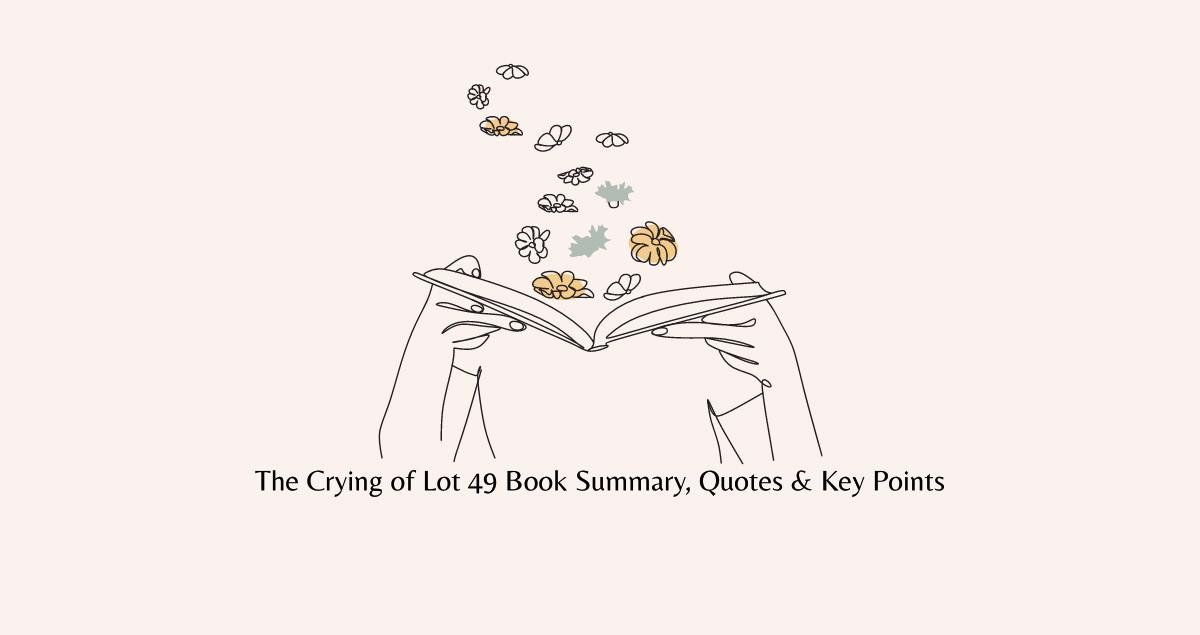The Crying of Lot 49 by Thomas Pynchon is a postmodern novel that follows the story of Oedipa Maas, a woman who becomes entangled in a conspiracy involving a secret underground mail system known as the Tristero. As Oedipa delves deeper into the mystery, she begins to question her own sanity and the reality of the world around her.
Table of Content
The Crying of Lot 49 Book Summary
Overview
The novel introduces us to Oedipa Maas, a woman who becomes the executor of her ex-boyfriend's estate. As she begins to carry out her duties, she discovers a series of clues that lead her to the Tristero, a secret underground mail system that may or may not exist. As she tries to unravel the mystery, she becomes increasingly paranoid and unsure of what is real.
Symbolism and Themes
The novel is filled with symbolism and themes, including the idea of communication and the breakdown of language, the role of technology in society, and the nature of reality itself. Pynchon uses a variety of symbols, such as the muted post horn, to convey these themes and create a sense of mystery and intrigue.
Plot Summary
The novel follows Oedipa as she tries to uncover the truth about the Tristero and its connection to her ex-boyfriend's estate. Along the way, she encounters a cast of eccentric characters, including a group of actors who perform a play about the Tristero, a former sailor who may or may not have been involved in the mail system, and a psychiatrist who may or may not be part of a larger conspiracy. As Oedipa delves deeper into the mystery, she begins to question her own sanity and the reality of the world around her.
Character Analysis
Oedipa Maas is the main character of the novel, and much of the story is told from her perspective. She is a complex character who is both intelligent and vulnerable, and her journey through the novel is one of self-discovery and self-doubt. Other important characters include Metzger, a former sailor who may or may not have been involved in the Tristero, and Mucho Maas, Oedipa's husband, who is struggling with his own sense of identity and purpose.
Style and Writing Techniques
Pynchon's writing style is often described as dense and complex, with a focus on wordplay and allusions to other works of literature. He also uses a variety of narrative techniques, such as shifting perspectives and non-linear storytelling, to create a sense of disorientation and confusion.
Historical Context
The Crying of Lot 49 was written in the 1960s, a time of great social and political upheaval in the United States. The novel reflects many of the concerns of the era, including the breakdown of traditional values and the rise of technology and mass media.
The Crying of Lot 49 Book Review
The Crying of Lot 49 is a challenging but rewarding novel that explores themes of communication, reality, and paranoia. Pynchon's writing style can be difficult to follow at times, but the novel's intricate plot and complex characters make it a compelling read. The novel is a classic example of postmodern literature, and its themes and ideas continue to resonate with readers today.
The Crying of Lot 49 Quotes
"The ordered swirl of houses and streets, from this high angle, sprang at her now with the same unexpected, astonishing clarity as the circuit card had. Though she knew even less about radios than about Southern Californians, there were to both outward patterns a hieroglyphic sense of concealed meaning, of an intent to communicate."
"She came to him towards morning. She entered very carefully, moving silently, floating through the dimness like a moth. She sat beside him for a long time without speaking, watching the colors of the window deepen, feeling the cold pane edge against her thigh."
The Crying of Lot 49 Key Points
Postmodernism
The Crying of Lot 49 is a classic example of postmodern literature, with its focus on fragmented narratives, multiple perspectives, and the breakdown of traditional values.
Paranoia
The novel explores the theme of paranoia, with Oedipa becoming increasingly unsure of what is real and what is not as she delves deeper into the mystery of the Tristero.
FAQs for The Crying of Lot 49
1. What is the significance of the title?
The title refers to a real estate development called Lot 49, which is mentioned briefly in the novel. However, the title is also symbolic, representing the idea of hidden meaning and the search for truth.
2. What is the meaning of the muted post horn symbol?
The muted post horn is a symbol of the Tristero, the secret underground mail system that is at the center of the novel's mystery. It represents the idea of hidden communication and the breakdown of language.
3. What is the role of Oedipa Maas in the story?
Oedipa is the main character of the novel, and much of the story is told from her perspective. She becomes embroiled in the mystery of the Tristero and begins to question her own sanity and the reality of the world around her.
4. What is the Tristero and how does it relate to the plot?
The Tristero is a secret underground mail system that may or may not exist. It is at the center of the novel's mystery, and Oedipa becomes increasingly obsessed with uncovering the truth about it.
5. What is the significance of the scene with the dentist?
The scene with the dentist is a surreal and unsettling moment in the novel, representing the breakdown of language and communication. It also serves as a metaphor for Oedipa's own sense of disorientation and confusion.
6. Is the book meant to be taken seriously or as a satire?
The novel can be read as both a serious exploration of complex themes and a satirical commentary on the state of society and culture in the 1960s.
7. What is the role of coincidence in the plot?
Coincidence plays a significant role in the novel, with many of the events and characters seemingly connected by chance. This reflects the novel's themes of hidden meaning and the breakdown of traditional narrative structures.
8. What is the significance of the final scene?
The final scene is open to interpretation, but it represents a moment of clarity and understanding for Oedipa. It also serves as a commentary on the nature of reality and the difficulty of finding truth in a complex and confusing world.
9. How does the book comment on society and culture?
The novel reflects many of the concerns of the 1960s, including the breakdown of traditional values and the rise of technology and mass media. It also explores the theme of paranoia, reflecting the sense of unease and uncertainty that many people felt during this time period.
10. What is the overall message or theme of the book?
The Crying of Lot 49 is a complex and multi-layered novel that explores themes of communication, reality, and paranoia. It is a commentary on the state of society and culture in the 1960s, and it continues to resonate with readers today.

